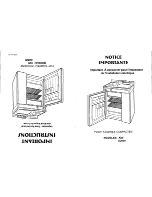
26
TK 56433-5-MM-EN
King service part numbers. Verify voltages are
measured from the designated terminal to the
alternator chassis ground. All voltages are DC voltages
unless otherwise noted.
Meter
Service Part Number
Fluke 23 Digital Multi-Meter
204-1079
Clamp-On Ammeter for above Meter
204-947
Alternator Load Test
Thermo King no longer recommends a full field test for
determining the alternator current output. Full fielding
an alternator can cause increases in alternator output
voltage that may damage internal alternator or unit
components. This damage may not be readily
apparent.
To test the alternator under load, Thermo King
recommends the use of a clamp-on ammeter to
monitor output current, both on initial startup and
under full unit load conditions. For example, on multi-
temp units, all remote evaporators should be turned
on.
General Diagnostic and Warranty
Evaluation Procedure
Complete the following diagnostic procedures before
replacing an alternator or the voltage regulator:
1.
When testing an alternator, use accurate
equipment such as a Thermo King P/N 204-1079
digital multimeter and a Thermo King P/N 204-947
amp clamp or equivalent.
2.
Verify the drive belts and pulleys of the charging
system are in good condition and are adjusted
properly before testing the alternator. Verify the
pulleys are the correct size. Worn belts, loose belts,
and worn or improperly sized pulleys will lower the
output of the alternator.
3.
The battery must be charged and in good
condition, the battery cable connections must be
clean and tight, and the 2A, 2 (sense), and EXC
(excitation) circuits must be connected properly. All
charging circuit connections must be clean and
secure.
N
No
otte
e:: If the unit battery is questionable, a known
good jumper battery should be substituted
for alternator testing.
N
No
otte
e:: Do not perform this test with a battery
charger connected to the unit battery.
N
No
otte
e:: All voltage readings should be taken between
the chassis ground on the alternator and the
terminals indicated, unless stated otherwise.
N
NO
OT
TIIC
CE
E
E
Eq
qu
uiip
pm
me
en
ntt D
Da
am
ma
ag
ge
e!!
E
En
ne
errg
giizziin
ng
g tth
he
e cciirrccu
uiitt w
wiitth
h tth
he
e rre
essiisstto
orr b
by
yp
pa
assss ffu
usse
e
iin
nsstta
alllle
ed
d w
wiillll d
da
am
ma
ag
ge
e T
Th
he
errm
mo
o K
Kiin
ng
g a
alltte
errn
na
atto
orrss..
T
Th
he
e rre
essiisstto
orr b
by
yp
pa
assss ffu
usse
e m
mu
usstt b
be
e rre
em
mo
ov
ve
ed
d ffo
orr
T
Th
he
errm
mo
o K
Kiin
ng
g a
alltte
errn
na
atto
orrss..
4.
Check that the resistor bypass fuse (F4) has been
removed. Units with Thermo King alternators must
have the resistor bypass fuse (F4) removed.
5.
Check and note the battery voltage at the battery
with the unit turned off.
6.
With the unit off, check the voltage at the B+
terminal on the alternator. Battery voltage must be
present. If not, check the 2A circuit and fuse F2 if
used.
7.
Disconnect the alternator harness from the voltage
regulator. On Thermo King alternators, carefully
push on the spring clip to release the plug lock.
8.
Turn the unit on, enter the Interface Board Test
Mode, and energize the Alternator Excite Output.
Refer to the appropriate Diagnostic Manual for
information about the Interface Board Test Mode.
9.
Check the voltage at the sense circuit (2 circuit).
Battery voltage should be present. If not, check the
sense circuit (2 circuit) in the alternator harness and
the main wire harness, and fuse F20 on the base
controller.
10. Check the voltage at the excitation circuit (EXC
circuit). 10 Vdc or more should be present. If not,
check the excitation circuit (EXC circuit) in the
alternator harness and the unified harness.
N
No
otte
e:: LED 18 lights up when the EXC circuit is
energized. The EXC circuit is operated by a
Smart FET so during normal operation the
unit must be running for the EXC circuit to be
energized.
11. Turn the unit off and reconnect the alternator
harness.
12. Attach a clamp-on ammeter around the 2A wire
connected to the B+ terminal on the alternator. All
wires connected to the B+ terminal must pass
through the clamp-on ammeter.
13. Connect a digital multi-meter between the B+
terminal at the alternator and chassis ground.
14. Turn the unit on and allow it to start. Using the
clamp-on ammeter, check the current flow in the 2A
wire.
•
A positive reading indicates the alternator is
charging. On unit startup, the current flow
should momentarily increase to allow for
battery current used during preheat and
cranking. Within a short time the current should
fall to normal unit load plus charge current to
the unit battery (typically 5-10 amps).
















































